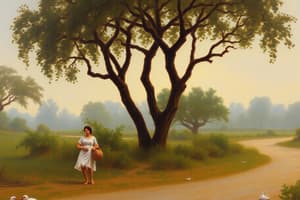Podcast
Questions and Answers
Which ancient Indian civilization is known for its sophisticated urban planning and drainage systems?
Which ancient Indian civilization is known for its sophisticated urban planning and drainage systems?
- Mauryan Empire
- Vedic Period
- Indus Valley Civilization (correct)
- Gupta Empire
Which of the following Indian festivals is NOT a festival of lights?
Which of the following Indian festivals is NOT a festival of lights?
- Diwali
- Navratri
- Durga Puja
- Holi (correct)
Which mountain range is NOT part of India's geographical landscape?
Which mountain range is NOT part of India's geographical landscape?
- Karakoram
- Aravalli
- Andes (correct)
- Himalayas
What is the primary sector of India's economy?
What is the primary sector of India's economy?
Which of the following is NOT a challenge faced by India's economy?
Which of the following is NOT a challenge faced by India's economy?
Which of the following is the highest peak in the Himalayas?
Which of the following is the highest peak in the Himalayas?
Which of the following is NOT a type of Indian classical music?
Which of the following is NOT a type of Indian classical music?
Which of the following Indian political parties is NOT a national party?
Which of the following Indian political parties is NOT a national party?
What is the name of the document that outlines India's system of governance?
What is the name of the document that outlines India's system of governance?
Which of the following is a characteristic of India's federal parliamentary republic?
Which of the following is a characteristic of India's federal parliamentary republic?
Flashcards are hidden until you start studying
Study Notes
History
- Ancient India (3300 BCE - 550 CE):
- Indus Valley Civilization (3300 BCE - 1300 BCE)
- Vedic Period (1500 BCE - 500 BCE)
- Mauryan Empire (322 BCE - 185 BCE)
- Gupta Empire (320 CE - 550 CE)
- Medieval India (550 CE - 1756 CE):
- Mughal Empire (1526 CE - 1756 CE)
- British Colonial Rule (1756 CE - 1947 CE)
- Independence and Modern India (1947 CE - present)
Culture
- Diversity:
- 22 official languages
- 8,000+ dialects
- Hinduism, Islam, Christianity, Sikhism, Buddhism, Jainism
- Traditions:
- Diwali (festival of lights)
- Holi (festival of colors)
- Navratri (nine nights)
- Yoga and Ayurveda
- Cuisine:
- Spices and herbs
- Rice, wheat, and lentils
- Vegetarian and non-vegetarian dishes
- Arts and Architecture:
- Taj Mahal
- Red Fort
- Indian classical music and dance
Geography
- Location: South Asia
- Borders: Pakistan, China, Nepal, Bhutan, Bangladesh, Myanmar
- Climate:
- Tropical wet and dry
- Subtropical and temperate
- Mountainous and desert regions
- Topography:
- Himalayas (highest peak: Mount Everest)
- Indo-Gangetic Plain
- Deccan Plateau
- Islands (Andaman and Nicobar, Lakshadweep)
Economy
- Developing economy
- 3rd largest economy in terms of PPP (Purchasing Power Parity)
- Sectors:
- Agriculture (rice, wheat, cotton, tea)
- Industry (textiles, steel, automobiles)
- Services (IT, business process outsourcing, pharmaceuticals)
- Challenges:
- Poverty and income inequality
- Corruption and bureaucratic red tape
- Infrastructure development
Politics
- Federal parliamentary republic
- Constitution: adopted in 1950
- Three branches of government:
- Executive (President, Prime Minister)
- Legislative (Parliament: Lok Sabha and Rajya Sabha)
- Judiciary (Supreme Court)
- Political parties:
- Indian National Congress
- Bharatiya Janata Party (BJP)
- Regional parties (e.g., Aam Aadmi Party, Dravida Munnetra Kazhagam)
History of India
- Ancient India (3300 BCE - 550 CE) was marked by:
- Indus Valley Civilization (3300 BCE - 1300 BCE)
- Vedic Period (1500 BCE - 500 BCE)
- Mauryan Empire (322 BCE - 185 BCE)
- Gupta Empire (320 CE - 550 CE)
- Medieval India (550 CE - 1756 CE) saw the rise of:
- Mughal Empire (1526 CE - 1756 CE)
- British Colonial Rule (1756 CE - 1947 CE) lasted for nearly two centuries
- Independence and Modern India (1947 CE - present) began with the country's independence from British rule
Indian Culture
- India's diversity is reflected in:
- 22 official languages
- Over 8,000 dialects
- Six major religions: Hinduism, Islam, Christianity, Sikhism, Buddhism, and Jainism
- Traditional festivals and practices include:
- Diwali (festival of lights)
- Holi (festival of colors)
- Navratri (nine nights)
- Yoga and Ayurveda
- Indian cuisine is characterized by:
- Extensive use of spices and herbs
- Staple foods: rice, wheat, and lentils
- Variety of vegetarian and non-vegetarian dishes
- India is famous for its:
- Architectural wonders: Taj Mahal and Red Fort
- Classical music and dance forms
Indian Geography
- India is located in South Asia, bordered by:
- Pakistan, China, Nepal, Bhutan, Bangladesh, and Myanmar
- Climate varies greatly, with:
- Tropical wet and dry regions
- Subtropical and temperate zones
- Mountainous and desert regions
- India's topography features:
- The Himalayas, with Mount Everest as the highest peak
- The Indo-Gangetic Plain
- The Deccan Plateau
- Island chains: Andaman and Nicobar, Lakshadweep
Indian Economy
- India has a developing economy, ranking 3rd in terms of PPP (Purchasing Power Parity)
- Key sectors include:
- Agriculture (rice, wheat, cotton, tea)
- Industry (textiles, steel, automobiles)
- Services (IT, business process outsourcing, pharmaceuticals)
- Challenges facing the economy include:
- Poverty and income inequality
- Corruption and bureaucratic red tape
- Infrastructure development
Indian Politics
- India is a federal parliamentary republic, with a constitution adopted in 1950
- The government consists of three branches:
- Executive (President, Prime Minister)
- Legislative (Parliament: Lok Sabha and Rajya Sabha)
- Judiciary (Supreme Court)
- Prominent political parties include:
- Indian National Congress
- Bharatiya Janata Party (BJP)
- Regional parties (e.g., Aam Aadmi Party, Dravida Munnetra Kazhagam)
Studying That Suits You
Use AI to generate personalized quizzes and flashcards to suit your learning preferences.




